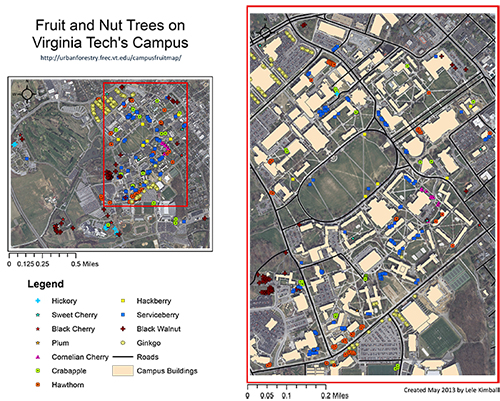Here at Virginia Tech we have an amazing resource of edible fruits and nuts in our urban forest on campus. This website is dedicated to sharing information about that resource in an effort to raise awareness about urban fruits in our community. If you click on the name of a species listed below, you’ll be linked to Virginia Tech’s vTree factsheets which provide valuable information for species identification. Locations of fruit and nut trees on this webpage are based on the Virginia Tech campus tree inventory which is a resource allowing precise navigation to the trees.
Click here for a larger view of the map
Benefits to Gathering Urban Fruit
- Gathering from our urban forest reduces waste and messy fruit drop.
- Urban fruit provides fresh, local and nutritious food to our community.
- Fruit gathering can be a socializing and recreational outdoor activity.
- Fruit found in the urban forest is often different from that in stores and can provide culturally significant foods to our diverse community.
- Fruit gathering is a fun educational opportunity for connecting with nature and our food.
Considerations when Gathering Urban Fruit
- Carefully identify the plant before you eat or collect the fruit.
- If you wish to harvest from a fruit tree located on private property, be sure to ask permission from the owner before gathering.
- Use appropriate picking tools to harvest so as not to damage the tree.
- Avoid gathering next to major roadways as there is much higher potential for the fruit to be contaminated with pollution.
- Urban landscape trees may be treated with pesticides not intended for human consumption, so use caution when collecting fruit and wash it thoroughly before consumption.
- Remember that the flavor of fruit will vary between trees of the same species so taste before you collect a basketful.
Edible Fruits and Nuts on Virginia Tech Campus
Sweet cherry (Prunus avium) ripens early to mid-summer, and black cherry (Prunus serotina) ripens late summer. Excellent eaten fresh and can be prepared into a variety of deserts or preserves. You can eat cherries from other ornamental or flowering cherries but they can be more bitter and sour. As with all true cherries, remember not to eat the pit as they contain cyanide and are toxic.
Recipes:Purple leaf plum (Prunus cerasifera) ripens mid to late summer. Can be eaten fresh, cooked or used for wine.
Recipes:Cornelian cherry (Cornus mas), actually a type of dogwood, produces small red berries ripening in late summer. The fruits can be eaten fresh or made into preserves, sorbet, wine or vodka. They can also be dried for a prune-like addition to cooking.
Recipes:
- Cornelian Cherry Marmalade: http://almostturkish.blogspot.com/2007/07/cornelian-cherry-marrmalade-kzlck.html
- http://www.motherearthnews.com/real-food/cornelian-cherries.aspx#axzz2SBFCWgwq
Crabapples (Malus spp.) ripen late summer or fall depending on the variety. The only difference between a crabapple and an apple is the size of the fruit; crabapples are less than 2” in diameter. They are usually quite tart because they have not been selectively bred for sweet flavor. Fruits are good for making preserves, cider, or sometimes pickled.
Recipes:
- http://www.uaf.edu/files/ces/publications-db/catalog/hec/FNH-00109.pdf.
- http://wildandslow.com/wp-content/uploads/2011/03/WILD_CRAB_APPLE_FINAL.pdf
Hawthorn (Crataegus spp.) produces a small bright red fruit that ripens in the fall. Though typically not eaten raw due to their tart taste, they are known for use in Chinese and Mexican cooking and make delicious jams and jellies and juices, or teas. Be sure not to eat the seeds because they can be poisonous. If cooking with them, strain out the seeds and if eating raw, spit out the seeds.
Recipes:
- http://www.eattheweeds.com/the-crataegus-clan-food-poison-2/
- Hawthorn Jelly: http://www.eatweeds.co.uk/hawthorn-jelly-recipe
Hackberry (Celtis occidentalis) berries ripen orange-red to dark purple in the fall. They can be eaten raw as a snack or prepared in jams, jellies, or wine.
Recipes:
- Hackberry Wine: http://winemaking.jackkeller.net/hackberr.asp
- Hackberry Jam: http://wildedibletexas.wordpress.com/2010/09/22/hackberry-jam/
Serviceberry (Amelanchier spp.) fruits look similar to a blueberries and ripen to dark purple or black in June. Watch closely because birds and other animals also like to eat them. Fruits can be used in pies or jams, wines, ciders or beers. When dried with a little sugar, they can be used in cereals, trail mixes or snacks. The berries are highly nutritious and high in antioxidants, similar to blueberries.
Recipes:Black walnut (Juglans nigra)nutsmature late summer to fall and can be collected directly from the tree of once they fall to the ground. They take a bit of processing time before they can be eaten because they must be husked and shelled before eating. The nut meat can be used similar to English walnut, commonly purchased in stores.
How to prepare:
- http://www.extension.umn.edu/yardandgarden/ygbriefs/h404blkwal.html
- http://web.extension.illinois.edu/cfiv/homeowners/991002.html
Hickory (Carya spp.)nutsmature late summer to fall. Nuts can be collected off the ground or from the tree. Nuts must be husked and shelled before eating. Some trees will have bitter nuts but others will have sweet nut meat inside. Pecan, for example is a specific type of hickory that is commercially produced. Nuts can be roasted and used for cooking or eaten fresh.
How to prepare:
- http://www.motherearthnews.com/real-food/hickory-nuts-zmaz80sozraw.aspx?PageId=1#axzz2VAkVQx8n
- http://www.pinenut.com/wild-crops-nuts-tea/hickory-nuts.shtml
Ginkgo (Ginkgo biloba) nuts mature in the fall and should be roasted or cooked before eating. The nut is surrounded by a pungent fruit-like exterior. Nuts should not be eaten in large quantities and some people who are allergic to mangoes or cashews should not eat them. Nuts are only on female trees.
How to prepare:
- http://www.seriouseats.com/2010/10/the-nasty-bits-gingko-nuts.html
- http://www.naturalnews.com/032866_ginkgo_nuts_nutrition.html
Disclaimer
This website is intended for informational purposes only. No warranties, written or implied, are made about the safety of consuming urban tree fruits or about the content of outside websites linked here. Use caution when collecting and consuming urban tree fruits.
~ to the top ~
Website: TSS 6/5/13
